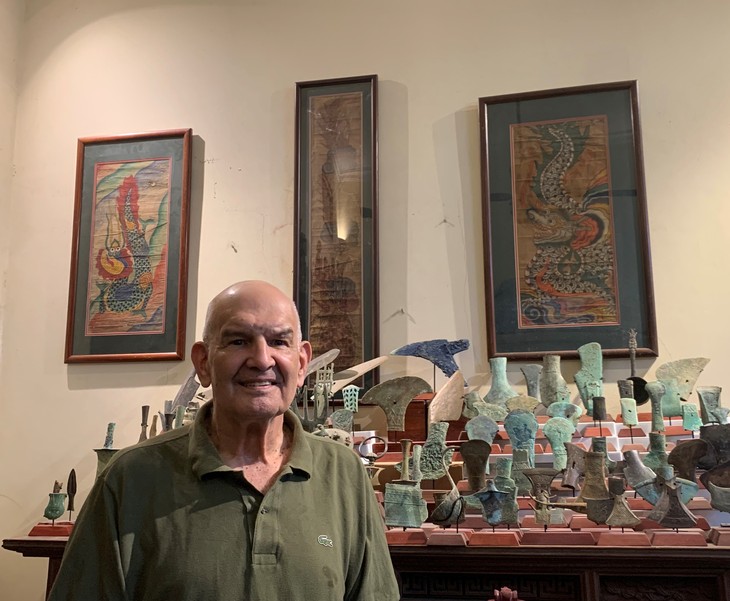 American collector Mark Rapoport and his antique collection (Photo credit: Mark Rapoport) American collector Mark Rapoport and his antique collection (Photo credit: Mark Rapoport) |
“I love Vietnam’s culture and the easy way to enter the culture and understand it is through an object. Vietnam has a wonderful situation from a collector’s point of view of having 54 ethnic groups, each with their own special kinds of objects and way of looking at the world and their way of presenting themselves.”
Rather than being just beautiful objects to look at, each antique holds a historical or cultural story behind it and collecting antiques can be a great way to learn about history and culture, says Mark.
During his 20 years living in Vietnam, Mark Rapoport has cultivated a love for Vietnamese ethnic cultures. He has amassed a huge collection of more than 10,000 items of the ethnic minorities in the northern and the Central Highlands of Vietnam.
Mark Rapoport first came to Vietnam as a medical student in 1969. He worked as a medical volunteer in hospitals across Da Nang City and in villages inhabited by ethnic people in the central province of Quang Ngai.
During a trip to a village in Quang Ngai, he set his eyes on a basket for holding cooked rice used by a local ethnic woman. And so she presented it to him. The second object that Mark acquired was a three-part backpack basket used by ethnic minority men. Those were the very first items Mark collected.
After that visit in Vietnam as a medical volunteer, Mark returned to New York to work as a pediatrician.
Having lived in Manhattan for dozens of years, Mark and his wife, Jane Hughes wanted a change of pace. They decided to travel around the world to break away from their daily routine. So far, they have visited more than 70 countries worldwide. They arrived in Hanoi in 2001 when Mark’s wife had a work project there and they decided to settle down.
“I’m a doctor, my wife is not a doctor but she runs health programs and she had health programs all over the world. When she went to check on her programs, I and sometimes our two children would go as well. And we would learn a bit about the cultures doing a little sightseeing when she finished her work. And some places you like, but some places you love, and we all got to love Hanoi,” Mark told VOV.
During the time Mark lived in Vietnam, his passion for collecting objects, especially those from Vietnam’s ethnic groups arose.
Mark says: “Of all the things I’ve collected over my life, material culture, that is the objects that people use every day, are the things that I’m attracted to most. They give you an insight into the people who made and used them. It’s opening a door to the culture in a way that you can’t duplicate any other way.”
After obtaining initial objects in Quang Ngai, he continued his journey to do research and collect more. When his collection became bigger and bigger and went up to more than 10,000 objects, Mark teamed up with his business partner Nguyen Thi Nhung, who is also an antique enthusiast, to open “54 Traditions Gallery” in downtown Hanoi to showcase his ultimate collection to the public.
“So, the first room will give the visitors a feeling of what we have and what it looks like. We have things from the Northern mountains, things from the Central Highlands region, but very few from the South. We also have things from the ancient cultures of Vietnam, the Kinh people and the people who came before them,” said Mark.
A room at the gallery is dedicated to Shamanism, which is a crucial part of the traditions and the spiritual life of many ethnic minority groups in Vietnam. Mark further elaborated: “The second room has things from the shamans only. Shamanism is seen all over the world. It’s a basic need of humans to try to know what the future holds, and maybe even to try to change it with prayers or things like that. The shaman is someone who can make contact with the spirit world, usually through a trance, and send the messages and hopefully influence the spirits.”
“So, we have all the things that they wear. These are masks that they wear on their forehead to call down the spirit of a particular god. These are useful instruments that they use in their ceremonies, a lot of bronze bells, things like cymbals. The instruments are not too different. You have bells, you have cymbals, you have gongs made out of metal, you have drums made out of wood with a leather coating. They are all used individually or sometimes together. Again, it’s very complicated and it depends on the particular group and the particular purpose of the ceremony that they’re having,” said Mark.
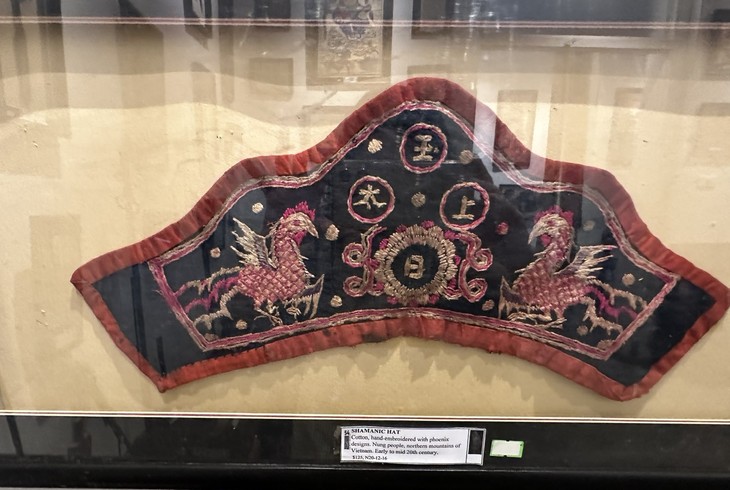 A Shamanic hat (Photo: VOV) A Shamanic hat (Photo: VOV) |
The antiques are displayed in the categories featuring the Central Highlands, tribal textiles, the Shamanic tradition, functional objects, water puppets, ornaments, labor tools, stone and bronze antiques. The diversity of the antiques shows the keen interest and great effort of the collector. In the massive collection of antiques, Mark is especially captivated by a small object, a rice cutter. For Mark, it is more than just a simple farming tool: “Small rice cutters are very simple objects and used every day in most of the cultures in the North, and surprisingly in other places like Indonesia and the Philippines. You basically need a piece of wood or something else, a small metal blade, usually about three centimeters long, and a cross piece that you wrap your fingers around to hold the cutter in your hand. Very simple. It doesn’t have to be fancy. There’s a snake’s head, usually the carving is done by men. It doesn’t help you work better. Sometimes you have romantic things, a man will make it for a woman. The reason I love it? Even though it’s a very small, minor object, it shows that the people have a love for beauty.”
 Rice cutters used by different ethnic minorities in Vietnam (Photo: VOV) Rice cutters used by different ethnic minorities in Vietnam (Photo: VOV) |
The increase in the number of antiques has expanded Mark’s knowledge about Vietnamese culture and motivated him to pursue his passion of collecting objects from Vietnam’s ethnic groups. He has spared no effort to study the origin and story behind the items he has collected.
Nguyen Thi Nhung, the co-founder of 54 Traditions Gallery, recalls: “When we first started doing business in 2004, Mark and I, we had different kinds of objects from the ethnic groups in the northern mountainous region of Vietnam, in the Central and Central Highlands of Vietnam. But for many objects we didn’t have much information about that. Mark and I worked very hard, especially Mark. He tried his best to work with museum experts here – sellers and collectors to learn more about the objects, to find out all the information related to the history of the objects, how people make them, how people use them, and on which occasions. After time, we built up our knowledge about the field. For many objects, even museum experts or collectors could not answer the questions for us, we had to travel to mountainous areas to visit tribal people, chiefs of the villages to seek the answers.”
Their approach is “anthropological” – which means that the value and appreciation of an object is increased when we know its purpose, when and why it was made and who made it, who used it, why it looks the way it does. All objects are described and accompanied by a fact sheet of at least 1,000 words, giving the details on the people who made the object, the materials used, its purpose and age and so on.
Some objects are still intact, but many are broken fragments. They are parts of an object reflecting a certain historical period of time. The fragments undergo some initial process before carefully being framed and attached with fact sheets.
“When I have a piece of broken furniture, first of all, I would like to know what kind of furniture it was, let’s say, part of an old table. Then I clean up a bit of something that has been sitting indoors or outdoors for a long time. The trick is to take off the dirt, but not the patina. Almost always there is patina in the bronze things that turn to blue-green. You don’t want to take that blue-green off, you don’t want to make it look new,” said Mark.
Beside his great passion for collecting antiques, Mark has also eagerly promoted Vietnamese culture. He has contributed a great number of exhibits to museums in Vietnam such as the Fine Arts Museum, the Vietnam Museum of Ethnology, the Vietnamese Women’s Museum and museums in the United States.
Thanks to his collection, many Americans, who previously knew very little about Vietnam, now comprehend more about the country and its culture. Ron Carver from Washington DC, visits the 54 Traditions Gallery during every trip he makes to Vietnam: “It’s funny because people in the US think of Vietnam as a backward country, but it isn’t backward at all. Going back thousands of years, there are people who were great artists and great artisans. Coming to this gallery, you can see the culture, the breadth of it, the evolution of it. Even dating back thousands of years ago, the artworks, the designs are just incredible.”
Last year Mark Rapoport donated approximately 500 pieces from his collection to the Vietnamese Women’s Museum. This is not the first time he has donated objects to the museum with a wish to share his beautiful treasures to the wider public. Mark said: “It’s a great pleasure to donate things here. A lot of Kinh people don’t know a great deal about the minority groups and this museum and the Ethnology Museum does a very good job of changing that.”
The objects donated to the Vietnamese Women’s Museum include jewelries, textiles, tools, and things used every day by ethnic minority women.
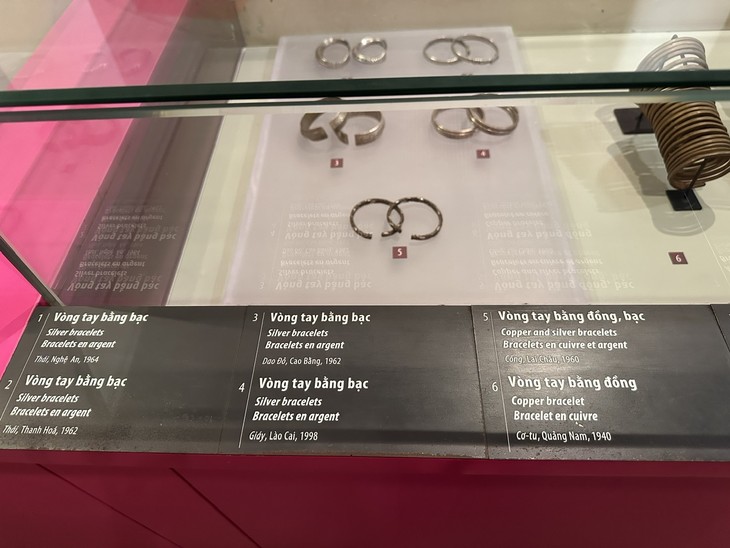 A collection of ornaments of Vietnam’s ethnic women (Photo: VOV) A collection of ornaments of Vietnam’s ethnic women (Photo: VOV) |
Mark said: “One of the things that people are interested in are the ear spools, they call them, that go through a large hole in the ear. When the children are small, they just put a piece of string there and they put very small ones, half a centimeter. And as a woman gets older, they enlarge the hole. Some of them are maybe four centimeters wide and that shows prestige, but it also shows wealth. Sometimes in the past, you went around villages in the Central Highlands, you’d see, old women, sometimes old men, but mostly women with just one.”
Mark is really impressed by the collection of baby hats which reflect Vietnamese traditions or customs. He said “In every village, you’ll find this special kind of hat for babies, even though women and men don’t wear hats day to day. And the reason for that is a general belief that there are bad spirits that fly around, and if they see a baby, they can come down and steal part of its soul. Well, you certainly don’t want that to happen to your child so you make a hat.”
“There’s one from the Muong that’s quite interesting. It’s covered with coins hanging on strings that are themselves covered with beads. Well, I think the basic idea of the hat is it looks like a flower. So, you put a lot of work into crafting an object, mostly it’s women who do the embroidering. That makes a statement, about the deep love that they have for their children,” said Mark.
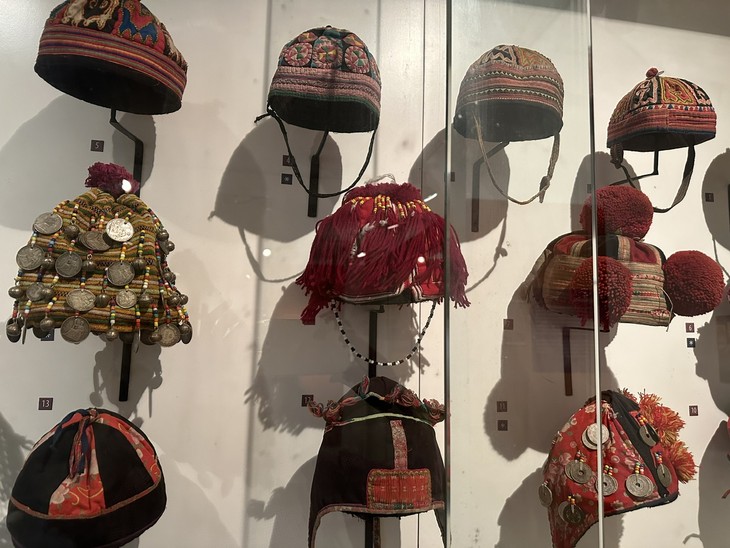 Children’s caps, traditionally made by the grandmother or the mother, the caps have special patterns, silver coins and amulets to protect the child from evil spirits (Photo: VOV) Children’s caps, traditionally made by the grandmother or the mother, the caps have special patterns, silver coins and amulets to protect the child from evil spirits (Photo: VOV) |
Mark’s antique collection gives a glimpse of Vietnam’s ethnic cultures, drawing the attention of many visitors.
Standing in front of a display of Vietnamese baskets, Melanie from Switzerland, who has come to Vietnam for the first time, feels amazed at the multiple uses of a bamboo belt basket in Vietnam. It somehow reflects Vietnamese culture and working practice. She said: “I have no idea of how to fish and the things around fishing techniques. The basket for me is really well-thought out – how to keep fish fresh in the water, and being able to keep the fish without going home. Yet, there are a lot of ways to do it. It’s like you have big diversity in the country, which I didn’t know before. It’s very interesting to see so many techniques, how they were thinking of keeping the fish, all the same purposes, but different ways to do it. It’s very cool.”
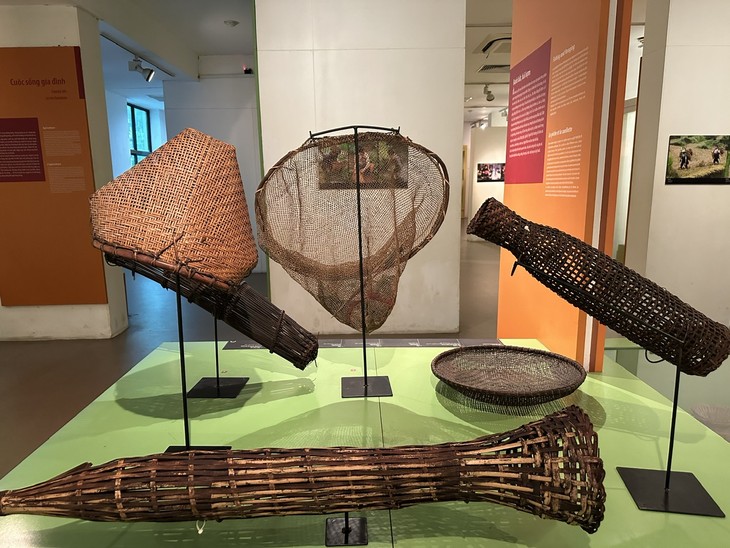 Fish trapping baskets are displayed at the Vietnamese Women's Museum Fish trapping baskets are displayed at the Vietnamese Women's Museum (Photo: VOV)
|
Tran Sinh Hung, another museum visitor, said he learnt a lot while seeing the collection of ornaments of ethnic minority women made in different periods of time.
“Those ornaments were elaborately made and show the skill of the artisans. I can’t believe that such sophisticated ornaments were made in the 18th century. Mark is so knowledgeable and he must have a great passion for Vietnamese culture to be able to collect such a massive number of antiques. His collection is so valuable in helping many, especially young Vietnamese people like us to understand more and cherish the identities and values of the Vietnamese culture,” said Hung.
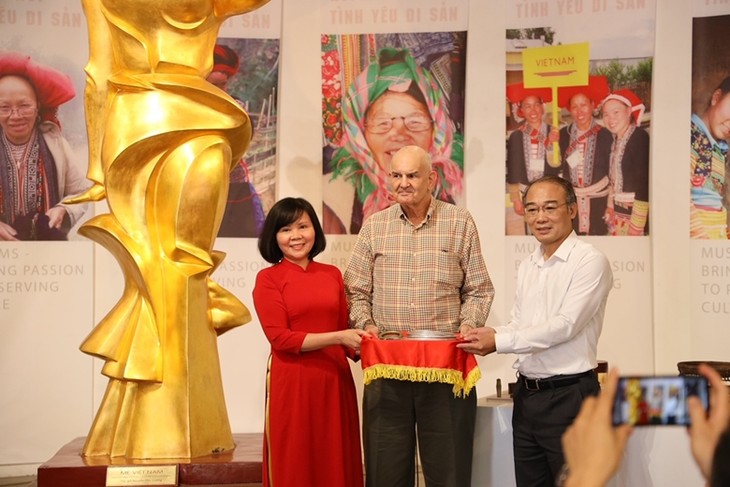 The Director of the Vietnamese Women’s Museum receives artifacts from Mr. Mark Rapoport (Photo: dangcongsan.vn) The Director of the Vietnamese Women’s Museum receives artifacts from Mr. Mark Rapoport (Photo: dangcongsan.vn) |
Tran Thi Ngoc Anh, Head of the Collections and Research Department of the Vietnamese Women’s Museum, said Mark’s collection is a precious and meaningful gift, adding to the museum’s huge object collections and facilitating their mission to preserve and promote Vietnam’s tangible and intangible cultural values. She said: “So far, Mark Rapoport has donated to the Vietnamese Women’s Museum more than 600 objects relating to Vietnam’s ethnic minority women. The objects include labor tools used by the women such as bamboo baskets, rice cutters, weaving tools and ornaments such as bracelets, necklets, and earrings. This is a precious collection which vividly reflects the cultural life of Vietnam’s ethnic women across the ages. Our museum has designed many events to introduce Mark’s collection. Last March, we organized a cultural event themed “Museums – where love for heritage blooms” which showcased Mark’s antique collection to the public. In the coming time, we plan to organize more thematic exhibitions about Vietnamese women, using the items from Mark’s collection.”
Having traveled to many areas of Vietnam, met with many Vietnamese people and collected myriad Vietnamese antiques, Mark thought that he should do something to repay his gratitude to the locals. During his trip to a village in a northern mountainous area, Mark saw an elderly lady trying to focus on her embroidery work, but it was hard for her due to her poor vision. Mark and his wife thought of helping elderly local women by presenting them with pairs of glasses.
“One of the things that my wife and I have been doing is taking reading glasses to the mountains when we go and just give them, especially to women because once they get old, their eyes aren’t good enough to embroider. My wife and I and our friends have distributed about 9,000 pairs of glasses,” said Mark.
He hopes that such pairs of glasses will help local ethnic minority women improve their livelihood and have a better life. That’s at least one thing he can do to give back to the locals.
At the age of 76, Mark is still busy with researching and finding good homes for his treasures. It’s a way to keep Vietnamese culture and historical values alive.